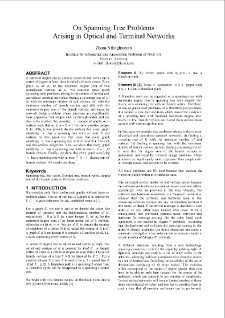Օբյեկտ
Վերնագիր: On Spanning Tree ProblemsArising in Optical and Terminal Networks
Ամփոփում:
A vertex of degree one in a tree is called an end vertex and a vertex of degree at least three is called a branch vertex For a graph G, let a2 be the minimum degree sum of two nonadjacent vertices in G. We consider three graph (spanning tree) problems arising in the context of optical and centralized terminal networks: finding a spanning tree of G: (i) with the minimum number of end vertices, (ii) with the minimum number of branch vertices and (iii) with the minimum degree sum of the branch vertices, motivated by network design problems where junctions are significantly more expensive than simple end- or through-nodes, and are thus to be avoided. We consider: (*) connected graphs on n vertices such that a2 > n — k + 1 for some positive integer fc. In 1976, it was proved (by the author) that every graph satisfying (*) has a spanning tree with at most k end vertices. In this paper we first show that every graph satisfying (*) has a spanning tree with at most k + 1 branch and end vertices altogether. Next, we show that every graph satisfying (*) has a spanning tree with at most (k — 1) /2 branch vertices. Finally, we show that every graph satisfying *) has a spanning tree with at most 3 ( k— 1) degree sum of branch vertices. All results are sharp.
Նույնականացուցիչ:
oai:noad.sci.am:135978
Լեզու:
URL:
Կազմակերպության անվանում:
Institute for Informatics and Automation Problems
Երկիր:
Տարի:
Ժամանակահատված:
Գիտաժողովի անվանում:
10 th International Conference on Computer Science and Information Technologies CSIT 2015
Վայր:
Մասնակցության տեսակը:
Օբյեկտի հավաքածուներ:
- Digital Library > Ակադեմիական ինստիտուտներ > ՀՀ ԳԱԱ Ինֆորմատիկայի և ավտոմատացման պրոբլեմների ինստիտուտ > Գիտաժողովներ
Վերջին անգամ ձևափոխված:
Mar 4, 2021
Մեր գրադարանում է սկսած:
Jul 28, 2020
Օբյեկտի բովանդակության հարվածների քանակ:
107
Օբյեկտի բոլոր հասանելի տարբերակները:
https://noad.sci.am/publication/149589
Ցույց տալ նկարագրությունը RDF ձևաչափով:
Ցույց տալ նկարագրությունը OAI-PMH ձևաչափով։
| Հրատարակության անուն | Ամսաթիվ |
|---|---|
| Zhora Nikoghosyan, On Spanning Tree ProblemsArising in Optical and Terminal Networks | Mar 4, 2021 |





